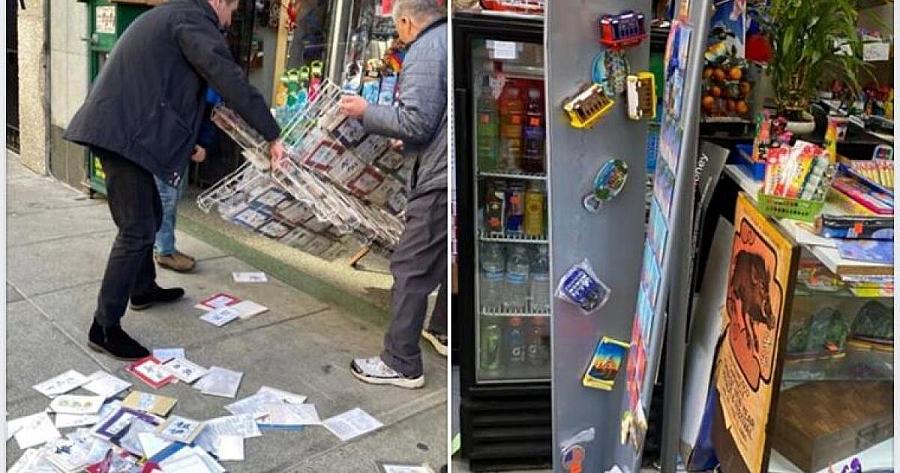A Veteran Journalist Explores the Tipping Point that Led To Her Deep Dive Into Anti-Asian Racism Amid The Covid-19 Pandemic

Vandals struck shops in San Francisco as the coronavirus lockdown began in California. Photo courtesy of Crimes Against Asians F
By Linda Jue
Editor’s Note: San Francisco-based writer and editor Linda Jue finally had enough. She’d felt the sting of being targeted by anti-Asian sentiment just as the coronavirus outbreak was pushing California into a dramatic lockdown. What ensued was reporting that echoed throughout the nation about verbal attacks, intimidation and physical assaults on Asians. Such hate has become a global problem, as detailed in a new report from Human Rights Watch.
Jue published her article in the San Francisco Public Press and discussed the disturbing phenomena on the program Your Call, on public radio station KALW. For palabra., Jue reveals what moved her to push back against the tide of racism spawned by COVID-19.
“You’re Chinese. Don’t ever forget that. You never know when they’ll send you back to China.”
As a teenager in the 1960s, I heard those words often as my father rebuked me for daring to think I was as American as anybody else.
I grew up believing in the American Dream of social mobility and equal opportunity. And, like the rest of my generation of young idealists, I was indignant that the dream wasn’t accessible to everyone. But we were inspired by the Civil Rights Movement. We believed in the fight. We believed that the strength of a democracy lies in its citizens’ commitment to the equal rights and freedoms our history books proclaimed America stood for. That I lived in San Francisco, in a multiracial community full of Civil Rights, labor and anti-Vietnam War activists, underscored that world view. So it irritated me to no end to have my father tell me I would never be a “real American.”
Decades later, his words returned to haunt me.
In early March, while dining out with a friend, a man seated at the next table looked up at me with a suspicious stare. He continued eyeing me intently throughout my dinner, which annoyed me. But I stifled the urge to call him out; to ask what his problem was.
Still, the encounter nagged at me for several days, until I realized the man’s problem was likely that I was Asian and that he was afraid I was carrying the coronavirus.
It wasn’t just me
The stare-down occurred in an upscale establishment in famously mellow, hip Marin County – just across the Golden Gate Bridge from San Francisco. This is not a remote area that sees few Asians. And though the incident was small, it was enough to shake me out of my complacency.
That man’s glare was the early warning signal of an ugly resurgence of anti-Asian sentiment, this time driven by a pandemic that originated in China.
Shortly after my experience, my 80-year-old aunt encountered hostile stares from white passersby during her daily walk, a neighborhood jaunt that she had taken for years without trouble. A Thai colleague added that neighbors approaching her were suddenly crossing the street. This was on her own block, and in notoriously radical Berkeley.
Then things escalated, not only in the San Francisco Bay Area but across the nation. By mid-March, Asians were being bullied, assaulted, spit on, sprayed with sanitizers, turned away from restaurants, chased off public transportation, and much worse. The last outbreak of anti-Asian violence had occurred in the 1980s, when the auto industry collapsed amid Japanese competition, throwing millions out of work. Anyone who looked Japanese was endangered.
This time it’s different. Violence is expected to worsen exponentially because of a pandemic that is killing people as well as jobs. White supremacists are using the pandemic to whip up fear and anger, and the anti-China rhetoric spewing forth from the Trump Administration is feeding those tensions.
After almost 40 years that saw Asian Americans rise in numbers and social and political influence, our fates are still tied to U.S. relations with China – as well as with all other Asian countries – just as my father predicted.
Plenty of hate to go around
These attacks are now occurring in the context of a pandemic that is throwing into high relief the ongoing systemic racism affecting all communities of color. Blacks, Native Americans and Latinx are suffering higher rates of COVID-19-related infections and deaths because of long-standing racial disparities in housing, employment and access to adequate medical care. Blacks and Latinx are subjected to more police abuse. White supremacy groups are openly targeting all people of color as well as Jews.
This hate transcends garden-variety street racism, and watchdogs of hate groups say it is tacitly encouraged by the White House. Consequently, civil rights and social justice organizations are forming national, multiracial coalitions. They recognize that a broad, coalescing force is necessary to counter attacks and address the deep inequities responsible for disproportionate death rates. Above all, they want to take control of distorted narratives about their communities that are now exacerbated by this pandemic.
That’s the trumpet call for all journalists, but especially for journalists of color. Instead of working within our group silos, can we come together to develop viable strategies that radically transform how our profession portrays people of color? Just as the pandemic is a pivot point for activists, it should also be a pivot point for journalists. It’s no exaggeration to say that people’s lives depend right now on our ability to communicate their stories effectively enough to be a powerful wake-up call for deep change. If we don’t mobilize, the aftermath of this pandemic will go on for years, long after a vaccine arrives.
This article first appeared on palabra., a digital news platform sponsored by the National Association of Hispanic Journalists.
